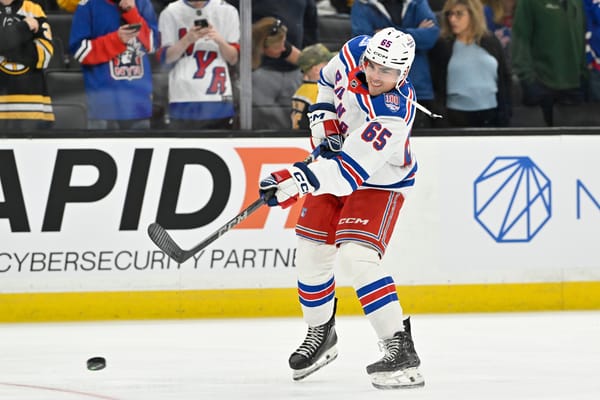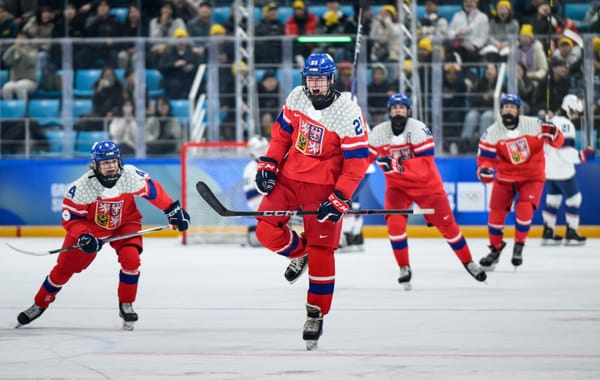Ty Ronning Can’t Stop Scoring in the WHL
Despite a solid cameo in Hartford at the end of last season, Ty Ronning did not earn a spot with the Wolf Pack out of training camp and instead was sent back to the WHL. As one of the older players in the league, he was expected to play well.
However, Ronning has exceeded expectations. A hat-trick last night against the Prince George Cougars gives him an astounding 39 goals through 44 games; the second-highest goal total in the league. On the surface, it’s a pleasant season for Ronning. But what does it mean as far as his future in hockey?
What’s interesting is how Ronning scores his goals. Whereas most small players rely on elite skill, Ronning counterintuitively is a more traditional north-south player. He has a pretty good wrist shot that he can score with, but otherwise puts home a number of his goals from around the crease. Though not a traditional highlight reel goal, this goal personifies Ronning perfectly. He gets absolutely clocked in the low slot, but immediately gets up and, undeterred, returns to the same spot before fighting his way to a loose puck and scoring.
Though he is generously listed at 5’9, he is in unbelievable shape. He’s hard to knock down, and he’s incredibly persistent. Thus, despite not possessing high-end skill, he has been a force in the offensive zone.
Age is important context for his scoring numbers. Ronning is technically playing an overage season, and is older than 90% of the league. In fact, nearly a third of the skaters in the WHL are a full two years younger than Ronning. The difference between an 18-year-old and 20-year-old is massive in terms of physical and mental development.
So, in order to put Ronning’s goal production into perspective, we need to compare him with similarly aged played in the WHL. I researched the top scorers in the WHL by goals-per-game over the last 20 seasons. Then, I filtered out the data to only contain players within range of Ronning’s age by six months (older or younger). Here were the results.
For players within reasonable range of his age over the last two decades, Ronning is one of the top scorers. Even within this list, it’s hard to compare. The gap between him and Pavel Brendl is the same as the gap between Brendl and the bottom.
Things get a bit more interesting when you only include five-on-five goals.
Five-on-five scoring is an important specification for prospect evaluation. Research has suggested that goals at full strength are a better indicator of future NHL success than power play goals are. Intuitively, this makes sense. There is a lot less room on the ice at pro levels. If a player can not generate goals at even strength in junior hockey, then what chance does he stand in the NHL? Furthermore, NHL coaches are not keen on placing power play specialists in their bottom-six (just ask Brandon Pirri). It’s not that PP goals are bad, but rather that a lack of five-on-five goals is a massive red flag. Ronning has done a fair share of his scoring at even strength, so there’s no concern there.
A problem with evaluating Ronning’s progress is that his birthday is right around the awkward cutoff date for AHL eligibility. Thus, a number of players around his age who would serve as a basis for comparison aren’t actually in the WHL. It creates an intriguing situation. For many prospects, we can look at historical trends of similar players and make a strong education guess about that prospect’s odds of NHL success. But Ronning is unique. He may instead be paving a path by which similar players will be evaluated in the future.
The few players with close numbers are either incomplete or problematic studies. Pavel Brendl and Nigel Dawes had shorts stints in the NHL before putting up incredible numbers in Europe. Had they been prospects today, where the league is more skill-based and open to analytics, would they have had full NHL careers?
The other players who hovered near Ronning’s production are Dryden Hunt, Jayce Hawryluk, and Adam Helewka; all recent WHL graduates. They are all currently putting up decent numbers in the AHL, and Hunt in particular has earned 11 NHL games with the Panthers. It’s too early to deem any of them successes or failures by NHL standards, but the door is still open for all three. Ronning has slightly outproduced them, and already had a nice cup of coffee with Hartford at a younger age. If in two years he is similarly producing in the AHL and knocking on the door of an NHL call-up, then the Rangers will feel awfully good about drafting him with one of the last picks of the seventh round in the 2016 NHL Draft.




